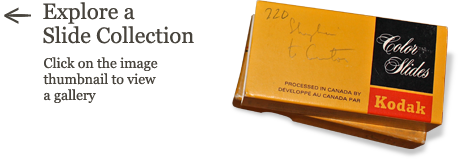The Photographs
Approximately 7,500 of Jock’s ~8,500 slides have survived. Jock housed the bulk of these in ~300 Kodak slide boxes. For the most part, he had numbered all of these boxes in chronological order, and also put the box number on every slide, also numbered, within each box. He had also briefly noted the locations where his travel slides were taken on the lids. About a decade after Jock began taking slides, Kodak itself began providing the month and year of development on each slide. This numbering first appears in Jock’s collection in May 1960. In the main Jock had his slides developed quite quickly after each trip.

Reviving Forgotten Images
Every attempt was made to identify the exact subject, day and place of each travel photograph, but there were obstacles to this exercise. Jock kept hundreds of slides in bundles outside of their original boxes for use in his lectures. Most of these slides had been rehoused in sturdier mounts and Jock often did not transfer their original location numbers to the new mounts. Jock had also inadvertently switched the lids of some boxes, or replaced slides in the wrong boxes. Often his writing was indecipherable, his spelling inaccurate or the names of places have changed in the intervening years. Information from letters, family diaries and books on his travels, put together with Jock’s numbering, helped to determine or confirm provenance and correct box location. Images found on the Internet of famous sites were also used for these purposes.
The photographs selected for inclusion on this website comprise about three percent of Jock’s surviving slides. Because they represent so few of the total, they do not include all the various types of subjects, all of the countries that Jock photographed nor all of his best photographs. A few images were included in order to give some context to others but for the most part, each photo chosen had to stand on its own merits.
Selection of slides was governed by a number of factors. Jock’s preferences were respected in that some were his preferred selections for use in talks, as evidenced by their being remounted in more durable holders with protective glass covers. In many cases excerpts from his own words in letters and books explain his special interest in the subject that he had recorded. Other photos were chosen because they were deemed beautiful, occasionally humorous, or were samples of people, places and activities of past times. Most of the photos chosen are older as they provide a more striking contrast with modern times. All had to be in some way interesting, if not fascinating.
Technical flaws in photos were ignored if the images had other merits. Sometimes the original shots had poor exposure or focus, the correction of which was beyond the capabilities of the scanning and editing processes. Some flaws are the result of long term storage. For example, a moiré effect is etched into some images, the result of the film’s being for decades in contact with the glass of the remounts. The technical limits of the scanner used result in echo lines surrounding parts of an image where the contrast is very high.
In preparing the scans, again the photographer’s intent was respected. Colour and lighting adjustments were concentrated on attempts to recapture the presumed original colour and exposures of the now faded slides. Few photos were cropped, other than in order to level the horizon.
